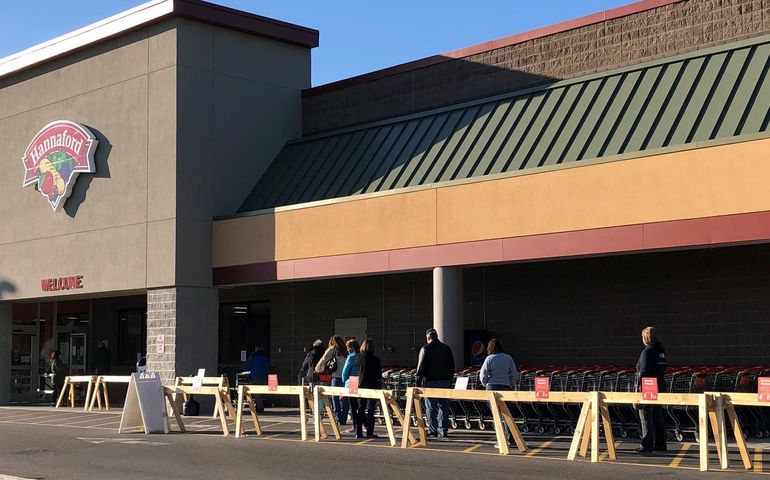As it hires another 2,000, Hannaford says communication is key to biz reopening
 Photo / Maureen Milliken
Shoppers enter the Turnpke Mall Hannaford in Augusta at 7 a.m. Thursday, when senior shopping hours began. Officials from the Scarborough-based supermarket chain are offering safety and distancing tips to retailers as the state begins to reopen.
Photo / Maureen Milliken
Shoppers enter the Turnpke Mall Hannaford in Augusta at 7 a.m. Thursday, when senior shopping hours began. Officials from the Scarborough-based supermarket chain are offering safety and distancing tips to retailers as the state begins to reopen.
Communication, listening and a healthy dose of empathy are key to operating a retail business while adhering to COVID-19 guidelines, something Hannaford supermarkets have learned first-hand, said Jim Hamilton,
"One of the most critical things is just strong communication out front to your associates and setting as much context to the changes as possible," said Hamilton, Hannaford vice president of retail operations. "It's really encouraging your leaders and associates in any establishment to be confident in the decisions they make to keep people safe and to adapt it to the business, but also to show patience and be open to feedback."
Hamilton spoke to reporters Wednesday about the store's process during the COVID-19 crisis. An essential business, Hannaford, and other supermarkets, have been open through restrictions the five states where it operates. The Scarborough-based company began implementing measures for 26,000 employees in 182 stores in Maine, New Hampshire, Vermont, Massachusetts and eastern upstate New York.
The store has increased wages, and has hired 2,200 employees in the five states since March. On Thursday it announced plans to hire another 2,000.
Store officials say that what Hannaford has learned since it began altering how its stores operated to meet federal and state guidelines may help other retailers as they are allowed to open. Much of it revolves around communicating and empathy, Hamilton said.
Some tips are:
Top priorities
One thing the company has been "very, very proud of" since it began focusing on enhanced pandemic-based health and safety guidelines March 27 is that listening has been a top priority.
"Listening [to] our leaders, who know the business and know how to run great stores," he said. "Listening to our associates, who have good insight, that are closest to the customers and can give us ideas on how we can be more safe and more effective; and then listening to the customer feedback.
"We're pretty used to strong customer feedback in this business," Hamilton said. "And I think that when you really listen in times like this, it just gives you a better preparation on how to adapt."
Being open to challenges is another key, he said.
"Be thinking in advance of some of the obstacles that may come up, and involve other people and listen to as many voices as possible," he said. "What we have learned is the more insight and the more feedback that we've received, the better the change and the more sustainable the change and better received at the retail end and the customer-facing perspective."
Sending a consistent message
Hamilton said that as the stores continues to take enhanced cleaning and social distancing steps, store leaders and employees are provided talking points so that the stores are sending a consistent message.
"If you don't do that in a business the size of Hannaford, then you can get different associates maybe misunderstanding a change, or not representing it adequately enough," he said.
The store has frequent socially distant "huddles" where changes are discussed.
"And we really encourage our associates to be part of owning the solution, whether that's educating someone on the 'why's' or helping them navigate the store differently, or educating them on the new process on how you would come up to a deli, or how you would shop at a food service case, we have a strong service focus with these changes," he said.
"That's been imperative to the 10 weeks, we've educated our associates as much as possible."
Navigating different guidelines, mandates
Hannaford, like many companies, not only dealing with local and state guidelines and mandates, but doing it across more than one state. Hamilton said there have been daily meetings with officials in different localities about what's expected and how to do it.
The key is to consider the entire company. "When a company makes changes only for that specific state, it can be hard to track and it can be hard to handle," he said. "And then messaging can get away from you."
His advice to other retailers is to make sure there's a team approach with leadership, to understand and stay on top of changes that are happening daily and to have good conversations with teams regarding implications around changes. He said it's also important to know the difference between a mandate and guideline. Some states mandated certain things that other ones only had as a guideline.
"Make sure you look at the broader organization and say, 'Does is make sense for us to make the change company-wide (rather than just in one state)?'" Particularly keeping in mind other states may soon follow with a similar mandate.
Having a good communication plan in place is key to making that work, as is getting it out in a timely manner to store leaders.
"I emphasize timely, because a lot of these changes happen so quickly and they're expected be in action as soon as reading about them in the newspaper," he said.
Employee, customer safety
Employees in Hannaford stores are temporarily required to wear masks; those who can't because of medical reasons wear a face shield. Customers are asked, but not required, to wear a mask.
"It's critically important that all our associates understand that it's their responsibility not only to protect themselves, but to protect our customers," Hamilton said. The company follows CDC guidelines, as well as following what states and municipalities recommend and mandate.
"First and foremost it was important for us to learn from the experts," he said. "And then to activate on securing the right face coverings for our associates, and then implementing the standard practices and communicating that to 26,000 people across the network."
The store has implemented one-way aisles; installed signs and markings on how to socially distance, and where; employees wear vests that have reminders about distancing; clear plastic partitions have been installed; and employees are pre-screened.
He said as the company hires new workers, emphasizing the safety measures is also important so that new hires know they'll be safe. The store's website has an extensive page on safety measures for both employees and customers.
The company has also leveraged technology to communicate at a higher level. Hamilton said, for instance, a recent robocall got informaiton out to 26,000 employees in less than three minutes.
Dealing with unhappy customers
A recognition that everyone is stressed out, that constantly changing guidelines and rules can be confusing, and that context helps get information across are important, he said.
"We clearly have to make sure that we train our associates in the property standards, but also to recognize that we set the right context wit our associates on the changes so that they're well-informed and that we provide talking points to them," he said. "We serve the whole community, and people have their own opinions and own beliefs when they come to the store about how they feel about the changes that are being made.
He said that people are dealing with a myriad of stresses in their lives. "So when people show up to our stores, they're already under a lot of different pressures," he said. And then they come in and find they have to navigate the store differently and follow different rules.
He said that as tensions flare, "Our associates have done a really phenomenal job, first and foremost, with empathizing with the fact that so many changes and so many different pressures people are coming in with, that people are needed to first, be heard, so we're showing a lot of patience and better understanding of what people's concerns are."
The company is also making sure it's consistent in how it's educating people about changes, so customers aren't getting mixed messages.
If things escalate, they work with the customer, employee, or even bring in local authorities, just as they would have pre-COVID-19.
"But I will tell you that most of our customers have been fantastic," he said.
Listening to customer feedback
As shoppers became less inclined to shop in person, the Hannaford-to-Go option offered at several stores, in which customers order online, then pick up at an allotted time, became overwhelmed. Originally, spots opened up at midnight. In many cases, those would fill in minutes.
"People were staying up late, until midnight, which is not ideal for anyone," Hamilton said. The company recently changed the time to 8 p.m. to make it easier for people. Hiring is also underway to increase Hannaford-to-Go availability.
That's an example, Hamilton said, of changes the company can make as customers weigh in that don't affect health and safety measures.
The store has also adjusted senior-only hours. Initially, they were from 6-7 a.m. But customers were lining up in the dark, and often the shelves weren't fully stocked by then.
"We moved from a 6 a.m. start to a 7 a.m. start, then we really asked for the community to be respectful, to allow the seniors, or those who need a little more time in the store, or a little more space in the store, to be respectful of that time."
He said many stores have long lines because of capacity constraints — depending on the size of the store, only 50, or 100, people can be allowed in at a time.
"We learned quickly that people want to know what's going on while they're queuing up so they're not surprised when they come into the store and find that they waited in line and we still don't have toilet paper," he said.
Where there are lines, he said, there are "better conversations" about what customers can expect when they come in "and what the reality is with product availability, so that they're fully informed."
"I think that strong communication has really assisted us in not only reconnecting with our customer on a higher level, but more importantly on how to tell the story on why we need the changes."
Learning for the future
Hannaford has followed CDC guidelines and other health and safety measures, something that won't change as long as COVID-19 is an issue, Hamilton said.
He said the company has also learned other long-term lessons from the past 10 weeks, including that convenience is a key driver of what's important to people now.
"People are not coming into the store as frequently as they were with smaller orders, they're doing larger shops," as well as stocking up on more fresh and convenient items. "So from a strategic point, we're learning how we can better serve that need."
He said the company is also looking at ways to change to further take advantage of increased customer use of ecommerce.
"We know that the way people interact with our brand is changing," he said. "We're going to do everything we can to ensure the safety of our customers and associates, but also evolve with the times to be a better service in providing fresh and convenient meals."














0 Comments